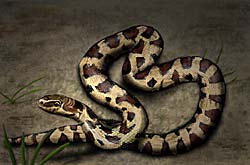|
|
|
|
|
|
Species Spotlight
on

Elaphe vulpina
| A.K.A. |
Fox Snake; Eastern
Fox Snake; Western Fox Snake.
|
||||||||||||
| SUBSPECIES |
Elaphe vulpina
gloydi - Common Name - Eastern Fox Snake
|
||||||||||||
| DESCRIPTION COLORATION |
Elaphe vulpina is more robust relative to other Elaphe species. The scales of the Fox Snake are keeled. Coloration = Yellow to light brown marked with dark brown to black splotches that maybe slightly red on it's sides and back. The adult snake's head may be slightly red. There is usually a dark band on the head in-between the eyes. There is a dark band from the eye to the corner of the mouth. The belly is yellow with black irregular square-like markings. Elaphe vulpina gloydi - Eastern Fox Snake has relatively larger and fewer splotches on it's back - approximately 34. Elaphe vulpina vulpina - Western Fox Snake has relatively smaller and more splotches on it's back - approximately 40.
|
||||||||||||
| SIZE |
3 to 5.5 Feet
|
||||||||||||
| HOME |
Elaphe vulpina gloydi - Within the Great Lakes basin. From Ontario to Ohio. Elaphe vulpina vulpina - Western area of the Great Lakes Basin. Western Upper Peninsula of Michigan, Wisconsin, Minnesota, Iowa, Indiana, Illinois, South Dakota, Nebraska, Missouri.
|
||||||||||||
| HABITAT |
Elaphe vulpina gloydi - Along the coasts of the Great Lakes (and slightly inland.); Marshes; In areas with cattails; Sand dunes; Farmland; Woodlands. Elaphe vulpina vulpina - Woodlands; Sand dune areas; Prairies; Farmland
|
||||||||||||
| LIFESTYLE |
Partially arboreal although, this snake is most often found on the ground. These snakes are very strong swimmers. Elaphe vulpina gloydi - Eastern Fox Snake is active from April to October. They tend to prefer a diurnal lifestyle, but during periods of extreme heat, they will hunt at night. They prefer to hibernate in abandoned mammal burrows. They have been known to hibernate in groups.
|
||||||||||||
| PREDATORS |
Egrets, hawks, herons, raccoons, foxes, mink. Hatchlings may fall prey to: fish, frogs, turtles, small mammals.
|
||||||||||||
|
DEFENSE
|
When threatened the fox snake will vibrate it's tail, mimicking a rattlesnake. These snakes will also discharge a foul smelling odor to serve as a defense. Although this snake is NOT poisonous, younger individuals have been known to strike at their attackers. | ||||||||||||
| FOOD |
Small mammals, birds, frogs, eggs, worms, insects.
|
||||||||||||
| BREEDING |
Elaphe vulpina is oviparous. Eggs are laid from June to July. Eggs are laid in soil, hollow logs, rotting stumps, sawdust piles, mammal burrows, under logs, under boards, under leaf litter. Clutches consist of 7-29 eggs. Eggs hatch in late summer. Hatchling coloration is similar to that of the adults.
|
||||||||||||
|
IN THE FIELD
|
The best time to see the Eastern Fox Snake in the wild is in May and June from 11 am to 7 PM. It has been sited in along the shores of the following bodies of water: Lake Erie, Lake Huron, Lake St. Clair, Raisin River, Detroit River, Clinton River, Shiawassee River. Most individuals are sited while they are basking. Fox snakes may sometimes be found on roads at night. Similar
Looking Species:
|
||||||||||||
| SPECIAL CONCERNS |
Although Elaphe
vulpina is common throughout most of it's range, this snake is a
threatened species in Michigan. This snake is sometimes mistakenly called a Copperhead due to it's slightly red head.
|
||||||||||||
|
If you would like more information, visit these other Web Sites: Elaphe vulpina - Fox Snake by Andrew Brinker - Michigan State University student Fox Snake - Elaphe vulpina - Reptiles and Amphibians of Minnesota Bibliography: Lee, Y. Special Animal Abstract for Elaphe vulpina gloydi (eastern fox snake). Lansing, MI: Michigan Natural Features Inventory, 2000 Holman, J. Alan, et al. Michigan Snakes. Michigan State University Extension: 1993 "Animal Tracks." Great Lakes Society of Herpetoculurists Newsletter, April 1997 Mattison, Chris. The Care of Reptiles and Amphibians in Captivity. New York, New York: Sterling Publishing Company Inc., 1992 |
|||||||||||||